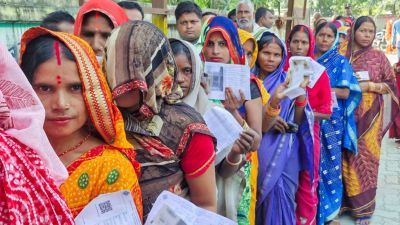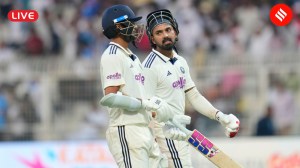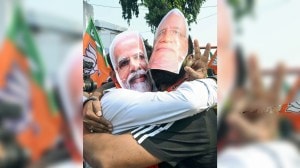Decode Politics | PM Modi’s ‘Muslim quota’ attack on Congress: What lies beneath?
14 Muslim groups identified as backward were given 4% quota in united Andhra in 2004; UPA govt's 4.5% sub-quota within OBC pool was quashed by court in 2012, but Cong's 2014 manifesto talked of a similar move
 Addressing an election rally in Tonk, he said that as soon as the Congress formed the government at the Centre in 2004, one of its first tasks was “reducing the SC/ST reservation in Andhra Pradesh” and giving it to Muslims. (PTI)
Addressing an election rally in Tonk, he said that as soon as the Congress formed the government at the Centre in 2004, one of its first tasks was “reducing the SC/ST reservation in Andhra Pradesh” and giving it to Muslims. (PTI)Prime Minister Narendra Modi Tuesday said the Congress tried to extend reservation on the basis of religion and give it to Muslims. Addressing an election rally in Tonk, he said that as soon as the Congress formed the government at the Centre in 2004, one of its first tasks was “reducing the SC/ST reservation in Andhra Pradesh” and giving it to Muslims.
“This was a pilot project which the Congress wanted to try in the entire country. Between 2004 and 2010, the Congress tried to implement Muslim reservation in Andhra Pradesh four times but due to legal hurdles and the awareness of the Supreme Court, it could not fulfill its intention… In 2011, the Congress tried to implement it throughout the country,” he said.
“I want to ask the Congress will it divide the reservation for Dalits and backward tribals and give it to Muslims,” he said, adding that it showed that the party did not “care about the Constitution and B R Ambedkar”, while he himself was dedicated to the statute.
Modi also said that when the BJP government in Karnataka got an opportunity, the first thing it did was to abolish the Muslim quota, “which was created by snatching it from STs/SCs”.
What was the PM referring to?
Andhra Pradesh
Reservation to Muslims in undivided Andhra Pradesh (including Telangana) was first proposed in 1993-1994 when the Kotla Vijayabhaskar Reddy-Congress led government set up a Minorities Welfare Ministry. In August 1994, a government order was issued providing a 5% quota to Muslims and 14 other castes in educational institutions and government jobs. It could not be implemented as the Congress lost in 1994 and 1999.
In 2004, the Congress made a 5% quota for Muslims an election promise. When Y S Rajasekhara Reddy led the party to power, he announced that the same would be implemented within two months. According to Mohd Ali Shabir, who was a minister in the YSR government and is an advisor to the current Telangana Congress government on minority affairs, the UPA government that came to power at the Centre gave full backing to the reservation.
However, several individuals moved the High Court, and the court asked the government to reduce the quota to 4% as it would otherwise breach the 50% ceiling.
Shabbir says the idea behind the reservation was to empower the socially and educationally backward among Muslims. “The 4% quota was not given based on religion but on backwardness, and only 14 groups identified by the Backward Class Commission and not the entire community got the benefit… Most importantly, the Muslim quota was given separately without reducing the reservation percentage of other communities,’’ he says.
However, the Telugu Desam Party and others continued to oppose a quota based on religion as “illegal” and said that it would affect the share of SCs/STs and backward classes in the state.
On March 25, 2010, hearing a PIL, the Supreme Court stayed implementation of the 4% Muslim quota, while ordering continuation of reservation for the same 14 categories under the economically backward classes category until further orders. It also referred the matter to a Constitutional Bench, which is still hearing the matter.
Congress
In its manifesto for the 2009 Lok Sabha polls, when it was seeking re-election to power, the Congress promised nationwide reservation for Muslims in jobs and education. The idea was to create a Muslim sub-quota within the 27% OBC quota.
“The Indian National Congress is irrevocably committed to ensuring that the Constitutional rights of all minorities are protected fully, that the representation of minorities in public administration increases substantially, and that minorities recognise that the government is working for their welfare at all times. The Indian National Congress has pioneered reservations for minorities in Kerala, Karnataka and Andhra Pradesh in government employment and education on the basis of their social and economic backwardness. We are committed to adopt this policy at the national level,” the manifesto said.
In October 2004, the UPA government set up the National Commission for Religious and Linguistic Minorities, popularly known as the Ranganath Misra panel, to suggest criteria for identification of SEBCs among religious and linguistic minorities and to suggest measures for their welfare.
The Misra panel recommended a 10% quota for Muslims and 5% for other minorities in government jobs and non-minority educational institutions. As an alternative route, it suggested carving out a sub-quota within the OBC quota.
UPA govt measures
In 2011, two years into its second term in power, the Minority Affairs Ministry of the UPA government proposed an 8.4% sub-quota within the OBC quota, including 6% for Muslims, based on the Misra panel report. This was later cut to 4.5% for minorities based on the Mandal Commission formula.
Then, just ahead of the 2012 Assembly elections in Uttar Pradesh, the UPA government announced the 4.5% sub-quota for minorities to be carved out of the 27% reservation for OBCs in Central government jobs and Central educational institutions. The timing was seen as aimed at the sizeable heartland Muslim vote bank and particularly the over two dozen caste groups recognised as backward Muslims in UP. The sub-quota was to be applicable to all minorities included in the Central list of OBCs.
In the 2009 Lok Sabha elections, the Congress had won 21 seats in UP, and the party hoped to ride on the sub-quota plank to woo the Muslim community.
The controversy
As the UPA government poll-eve move was questioned, the Election Commision stepped in and asked the Manmohan Singh government not to implement the quota till the end of elections in five states, including UP.
What further fanned the row was a statement by then Law Minister Salman Khurshid, who also held charge of the Minority Affairs Ministry, while campaigning in UP, that the Congress would give 9% reservation to backward minorities in the state if the party won. The EC then issued a show-cause notice to Khurshid, asking him to explain why action should not be initiated against him. In February 2012, it censured Khurshid for violating the Model Code of Conduct.
However, Khurshid remained defiant, questioning the poll body’s authority to censure him as Law Minister, prompting the then Chief Election Commissioner S Y Quraishi to write to then President Pratibha Patil, complaining against the minister for challenging the EC. The President forwarded the letter to then Prime Minister Manmohan Singh.
Finally, Khurshid backtracked. “I treat this matter as unfortunate and regret the statement. I bow to the wisdom of the Election Commission and remain personally committed to ensuring that such situations do not arise,” he said in a letter to Quraishi.
Six days later, the EC put out a statement saying: “Based on the Minister’s clear change of position as conveyed directly to the Commission, it has been decided not to take any further action in the matter.”
In May 2012, the Andhra Pradesh High Court quashed the UPA government’s 4.5% sub-quota move saying the Office Memorandum creating it was based on religious grounds and not on any other consideration. The government approached the Supreme Court, but it refused to stay the High Court order.
In its 2014 Lok Sabha elections manifesto, the Congress said its UPA government had taken steps to address the conditions of backward minorities by aiming to provide them reservation in educational institutions and in government employment, and added: “We will pursue this matter closely in Court and ensure that the policy is implemented through proper legislation.”
Karnataka
In March 2023, ahead of the Assembly elections in Karnataka, the then BJP government in the state scrapped the 4% reservation granted to Muslims under the “2B” backward class category and shifted the community to the 10% quota pool for general category EWS.
The quota for Muslims in government jobs and education on the basis of their social and educational backwardness in Karnataka was generally perceived to have been introduced in 1994 by H D Deve Gowda when he was the CM. However, the move by his Janata Dal government, through the creation of the “2B” category for Muslims, was the continuation of a process that began in 1918 during the rule of the then Mysore princely state. Muslims were in fact identified through scientific inquiries by multiple state commissions as being “socially backward”.
Deve Gowda and his party JD(S) are incidentally allies of the BJP in Karnataka now.
with inputs from ENS, Bengaluru



- 01
- 02
- 03
- 04
- 05



























